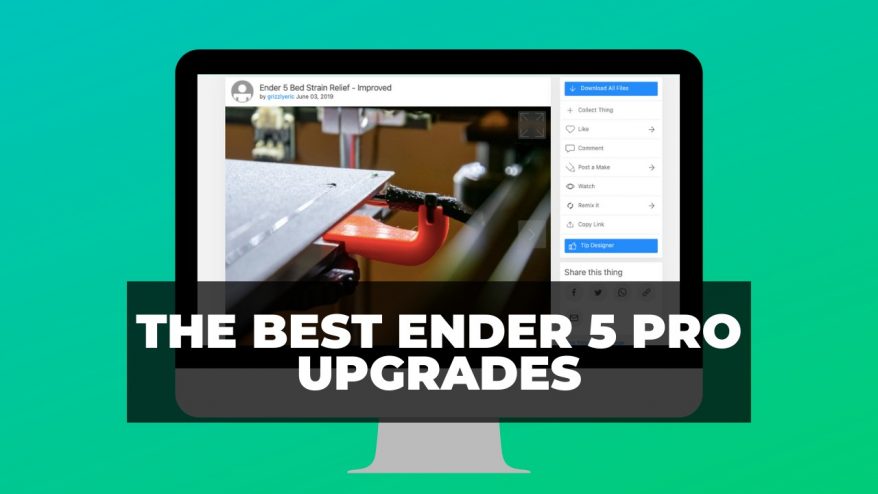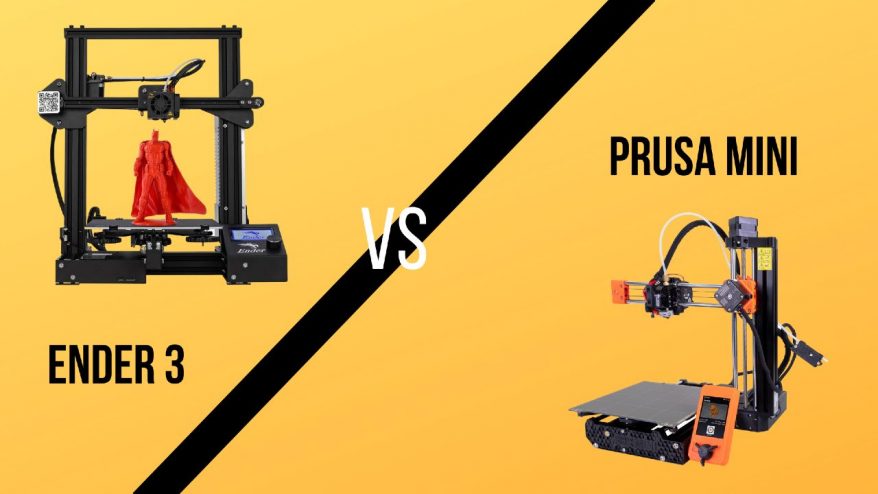
Prusa MINI vs Creality Ender 3 / Pro / V2? Which one is the best? Decisions, decisions, decisions.
The Prusa MINI is generally considered to be the more advanced and reliable printer, suitable for intermediate to advanced users, while the Ender 3 is a popular budget option, suitable for beginners with plenty of upgrade potential.
They’re the two most popular choices – but you may also choose to opt for the larger Ender 3 V2 or Pro if you need more build volume.
In this guide, I’ll compare all four candidates for the ultimate budget royalty head-to-head based on my hands-on experience to help you make a confident choice.
We’ll discuss the differences across all the key metrics – ease of use, print quality, value for money, and everything else you need to know
Does the diminutive Prusa MINI have enough printing pep to loosen the proven Ender 3’s firm grip on the entry-level 3D printing market? Let’s find out.
OUT-OF-THE-BOX PICK
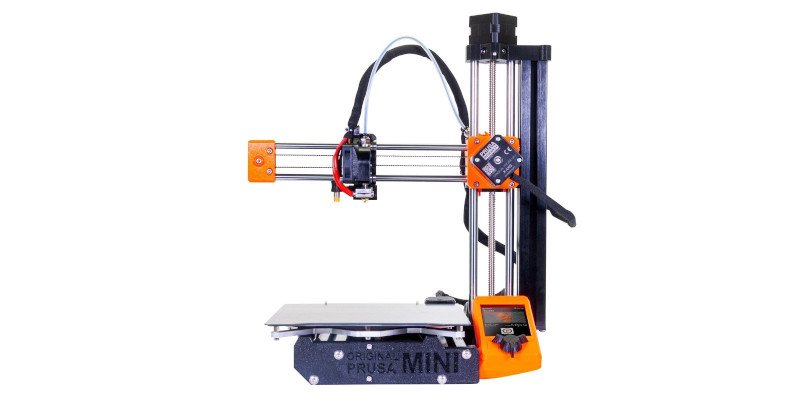
Prusa MINI
Available at:
BUILD VOLUME PICK
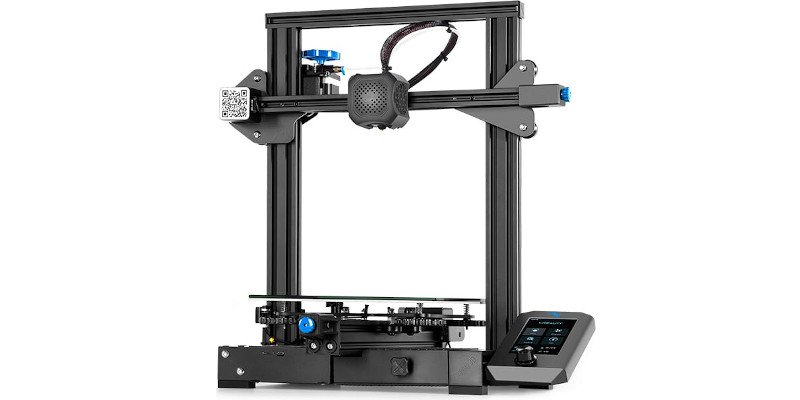
Ender 3 V2
Available at:
Prusa MINI vs Creality Ender 3 / Pro / V2 – Meet The Contenders
Creality Ender 3
- Where to buy: Creality official store here
- Printing technology: FDM
- Build volume: 220 x 220 x 250 mm
- Filament compatibility: PLA, ABS, TPU, PETG
- Layer height: 100-400 microns
- Printing accuracy: ± 0.1 mm
- Max extruder temp: 255°
- Max bed temp: 110°
- Connectivity: USB, SD Card
Pros
Has some standout features.
One of the best budget 3D printers.
Cons
Wobble-prone plastic Y-axis extrusion.
Manual bed leveling.
The original Creality Ender 3 burst onto the 3D printing scene in 2017 and, in one fell swoop, changed the budget landscape, with an impact that still echoes today.
800,000 units shipped and counting attests to the Ender 3’s abiding popularity.
The Ender 3 offers a roomy 220 x 220 x 250 mm build volume, a heated BuildTak-like build plate, a power recovery mode, and support for PLA, ABS, PETG, and TPU printing, to name the standout features.
The Ender 3 isn’t without its faults, though.
Its wobble-prone plastic Y-axis extrusion has been the subject of much debate, and manual bed leveling feels outdated in this day and age of low-cost auto-leveling probes.
Although several contenders and copycats have appeared in the intervening year and the specification sheet is no longer as eye-catching, the vanilla Ender 3 remains a benchmark for all value-packed printers out there.
A strong buy for first-timers or cash-strapped makers with bucket loads of upgrade potential.
Read more: our Creality Ender 3 review
Creality Ender 3 Pro
- Where to buy: Creality official store here
- Printing technology: FDM
- Build volume: 220 x 220 x 250 mm
- Filament compatibility: PLA, ABS, TPU, PETG
- Layer height: 100-400 microns
- Printing accuracy: ± 0.1 mm
- Max extruder temp: 255°
- Max bed temp: 110°
- Connectivity: USB, SD Card
Pros
New and improved wider Y-axis aluminum extrusion, patching the wobble woes of the Ender 3.
Slim and quieter power supply.
Cons
Some will find the upgrades not worth the extra $100.
With the Ender 3 having obtained household name status, Creality brought out the Ender 3 Pro to address some of the original’s most glaring issues.
The price tag also surged upwards to finance those enhancements, bringing the Ender 3 Pro into the sub $300 segment.
Among the most notable changes is new and improved wider Y-axis 40×40 aluminum extrusion, patching up the wobble woes of the Ender 3.
A slimmer and quieter Mean Well power supply unit, a textured removable magnetic bed, an improved MK-8 extruder, larger bed leveling nuts, and a smarter repositioning of the motherboard fan spruce up the Ender 3 Pro compared to the original.
The question here is whether these enhancements warrant the roughly extra $100 Creality levies for the Ender 3 Pro.
While the Ender 3 Pro benefits from tangible improvements that make printing easier, is it worth paying slightly more for the refreshed 2020 Ender 3 V2 or even the Prusa MINI?
Creality Ender 3 V2
- Where to buy: Creality official store here
- Printing technology: FDM
- Build volume: 220 x 220 x 250 mm
- Filament compatibility: PLA, ABS, TPU, PETG
- Layer height: 100-400 microns
- Printing accuracy: ± 0.1 mm
- Max extruder temp: 255°
- Max bed temp: 110°
- Connectivity: USB, SD Card
Pros
The best Ender 3 yet.
Many upgrades and quality-of-life enhancements over the previous Ender 3 printers.
Provides meaningful upgrades, unlike the Ender 3 Pro.
Cons
Can be a little pricey for those on a tight budget.
Rounding up our overview of the Ender 3 family, we have the Creality Ender V2.
While not a complete overhaul of the Ender 3, the Ender 3 V2 takes the same core easy-to-use budget printing experience and injects a series of transformative upgrades that, in our estimation, make it the best Ender 3 yet.
Aesthetically and construction-wise, the Ender 3 V2 diverts from its predecessor with a sleek, sheet metal injection and plastic panel design, abandoning the cheaper look for something wholly more pleasing.
On the technical side, the Ender 3 V2 now includes a silent 32-bit motherboard, TMC2208 stepper motor drivers, and a tempered carborundum glass platform, a significant adherence upgrade over even the Ender 3 Pro’s magnetic plate that also speeds up bed heating.
Creality has also added several quality-of-life enhancements that make using the Ender 3 V2 more enjoyable long-term.
These include a new detachable 4.3-inch HD color screen, a nifty, if a little gimmicky, toolbox embedded into the printer’s base, and XY-axis tensioners to keep belts taut.
As the most sophisticated budget Creality printer yet, the Ender 3 V2 succeeds where the Pro falters in that it provides a meaningful upgrade over the original that’s well worth the extra cost.
Prusa MINI
- Where to buy: Prusa official store here
- Printing technology: FDM
- Build volume: 180 x 180 x 180 mm
- Filament compatibility: PLA, PETG, ASA, ABS, PC, CPE, PVA, PVB, HIPS, PP
- Layer height: 50-250 microns
- Max extruder temp: 280°
- Max bed temp: 100°
- Connectivity: USB, Ethernet
Pros
Borrows most of the technical know-how from the Prusa i3 MK3S+ for half the price.
Sports an excellent heated removable magnetic PEI-coated bed.
Can tackle a generous range of materials.
Cons
Small print area.
The Prusa MINI represents Prusa’s first foray into the budget sector to duke it out with, predominantly, the Ender series.
The Prusa MINI borrows much of the technical know-how and lashings of the market-leading usability found in Prusa’s i3 MK3S+ crown jewel, but at less than half the cost.
As the name implies, it’s a modest, toy-sized printer, but behind a small footprint lies a sleek, uncluttered, and confident 3D printing machine capable of print quality that all but equals the full-fat i3 MK3S+.
The Prusa Mini sports an excellent heated removable magnetic PEI-coated bed.
Alongside, the MINI can tackle a generous range of materials, including PLA, ABS, PETG, ASA, PC, and HIPS. It also does away with the standard SD Card connectivity for both USB and Ethernet.
Finally, a 2.8″ full-color LCD, fully-automatic mesh bed leveling, and well-guided kit assembly round-off the baked-in usability that courses through the Prusa MINI’s entire design.
Prusa’s expertise in creating reliable and convenient 3D printers shines through with the Prusa Mini.
Whether you’re buying your first printer or looking to level up to a premium-budget machine, the Prusa MINI should serve you well.
Prusa MINI vs Creality Ender 3 / Pro / V2 – At a Glance
Now that we’ve got a sense of what each printer has to offer, it’s time to hone in on what sets them apart.
But, keep in mind that use case and, ultimately, budget are the final adjudicators of whether the Ender 3, Ender 3 Pro, Ender 3 V2, or Prusa MINI is the right and best printer for you.
For all-out bang-for-your-buck, balanced out by the best print quality and performance under $200, the Ender 3 is the uncontested winner.
The fact it’s highly modifiable and the wide availability of upgrades means you can tweak it to a make-shift Ender Pro for much less than its successor’s respective asking price.
If you’re prepared to spend $100 to $150 more, then the waters murk with both the souped-up Ender 3 V2 and the small but mighty Prusa MINI joining the fray.
With these two head-to-head, we’re once again back to printing needs. Is a large build volume more important than overall usability and convenience? Do you need broader material compatibility above all else, and so on?
Prusa MINI vs Creality Ender 3 / Pro / V2 – Comparison Showdown
Build Volume
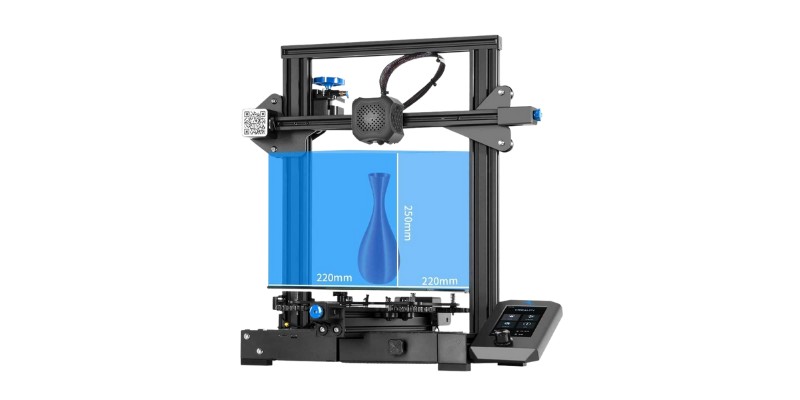
All three Ender 3 printers have a build volume of 220 x 220 x 250 mm. Stacked against the Prusa MINI comparatively cramped 180 x 180 x 180 mm, we have a clear winner.
The Ender 3 opens up more possibilities and variety in print types and sizes.
Considered in the context of the budget, beginner-friendly segment, the Prusa MINI’s 180 x 180 x 180 mm build volume should be sufficient to cover all the most popular hobbyist prints. It’s enough for models, toys, household items like vases, and any other homemade trinket you can think of.
Indeed, if we were to push the Prusa MINI to its limit, we’d still get an 18 cm² cube of plastic. Failing that, you can still fall back on printing an object in parts.
That said, there’s no skirting around the fact that the Ender 3 trumps the Prusa MINI in build volume.
While we’d be surprised if newcomers made anything exceeding that build area, it’s still small by budget 3D printer standards. If you need plenty of build area, the Ender 3 takes the lead.
Winner: Ender 3
Print Bed
The type and quality of the build plate are where our four contenders distinguish themselves most from one another.
The Ender 3 features a fairly basic, serviceable, fixed heated BuildTak-style print bed, which more often than not benefits from some adhesive love (glue, hair spray, etc.).
The Ender 3 Pro has a flexible, textured, and removable C-MAG magnetic print bed. The Ender 3 V2 goes even further, drafting in a tempered carborundum glass platform, arguably the best 3D printing solution for adhesion and easy finished print removal.
The Prusa MINI features a removable textured magnetic PEI-coated spring steel bed.
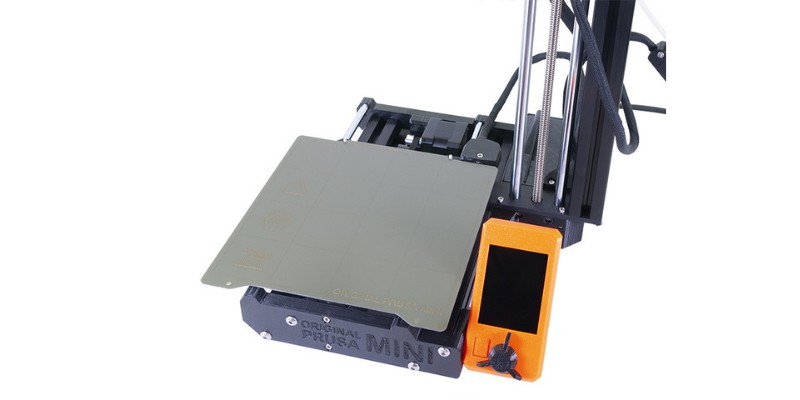
Because of shaped edges that sit snugly between screws on the printer itself, the alignment of the plate is far superior on the Prusa MINI than even the Ender 3 V2’s glass plate.
For that reason alone, the Prusa MINI eclipses the Ender 3 at its best.
Winner: Prusa MINI
Bed Leveling
The Ender 3 bunch all feature manual bed leveling, although the Ender 3 V2’s larger and labeled leveling knobs housed under each corner of the build platform simplify the process considerably.
The Prusa MINI delegates leveling duties to clever point-based fully-automatic mesh bed calibration and sensorless homing.
Manual bed leveling is no fun, even if you’re a weathered maker. Prusa’s hands-off mesh leveling works a treat, optimizing the MINI for problem-free printing.
A clear winner here for convenience alone and a welcome feature for first-timers eager to get printing without tinkering for hours beforehand.
Winner: Prusa MINI
Ease of Use
The Ender 3, in its three iterations, comes semi-assembled, with more or less identical assembly paths in both components and the time involved to piece them into a functional printer.
The Prusa MINI ships either as a kit or semi-assembled, the latter costing $50 more for the pleasure.
While the kit build isn’t particularly taxing or beyond the means of a curious beginner and offers a crash course in the principles and hardware of 3D printing, semi-assembled printers are just more convenient.
Something that also plays into usability is interfacing with the printer.
The Ender 3 and Pro’s LCD feels aged, especially compared to the sleek 2.8″ full-color LCD on the Prusa MINI and the entirely redesigned 4.3″ HD color screen. The MINI nudges ever so slightly ahead for offering on-screen print preview.
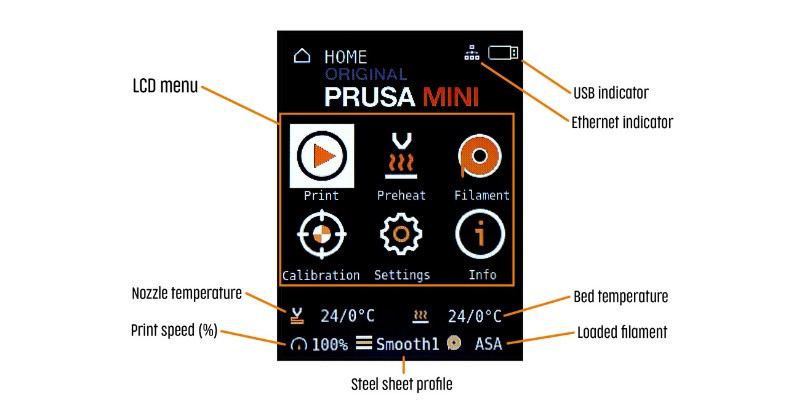
More granular usability features on the Ender 3 V2, such as belt tensioners, the handy toolbox, and a new rotary knob to feed filament into the extruder, make it a more enjoyable printer to use than its siblings.
Still, the Prusa MINI’s overall experience is smoother.
Winner: Prusa MINI
Prusa MINI vs Creality Ender 3 / Pro / V2 – Price
While price is somewhat a misleading indicator of a printer’s overall merit, we’re all bound to a budget. It’s an essential factor to keep in mind and often a deciding one, especially in the budget range.
The Ender 3 currently sells on the Creality shop for $189.00, while the Ender 3 Pro is available for a steeper $219.00. The Ender 3 V2 pushes the price to $262.00.
Jumping over to the Prusa MINI, you’ll find it priced at $349 in kit form.
The Ender 3 packs an awful lot of value into that $189.00, and the print quality is remarkable for the price.
As for the Ender 3 Pro, we don’t feel the minor improvements over the original genuinely warrant that extra $30, especially as you can splash out a further $40 and get the vastly improved Ender 3 V2.
With all its usability, convenience, and features such as auto bed leveling, the Prusa MINI justifies its price, but for us, the Ender 3 V2 comes out on top.
If $262.00 blows past your allocated budget, the Ender 3 is a solid fallback option.
Winner: Ender 3 V2
Upgrade Potential
For the fruit of hordes of engaged Ender 3 owners, there’s no end to resources, mods, and upgrades conjured up by the community surrounding the printer in all its guises.
The open design also makes it particularly mod-friendly, and Creality has a trove of accessories and upgrades for sale to simplify the process if 3D printing your own parts isn’t your cup of tea.
When it comes to the Prusa MINI, it’s not as suited to upgrades and hacking as the Ender 3 printers.
It’s not because it has a tightly controlled ecosystem or because Prusa makes it inordinately hard to tear the machine apart, but simply because it already sports all the upgrades it could ever need.
The Ender 3 is prized for baked-in ease-of-use and quick assembly that pose little in the way of obstacles to pumping out excellent quality prints for the price, rivaling printers three times the price.
Much of its popularity comes from a mod and upgrade-friendly design, something the vibrant Ender community has embraced, birthing all manner of 3D printed add-ons and hacks.
Defining a clear winner here is problematic.
The Prusa MINI has it all, but on the other hand, the Ender 3 offers plenty of scope to fine-tune and improve the printer to suit your preferences. A great option for hands-on makers or beginners looking to dive into the more technical aspects of 3D printing.
Winner: Draw
Read more: the best Ender 3 upgrades
Material Compatibility
When it comes to material compatibility, the three Ender 3 printers all exist on a level playing field and are compatible with your standard PLA, ABS, TPU, and PETG.
On the other hand, the Prusa MINI broadens the cluster of compatible filaments to include:
- PLA
- ABS
- TPU
- PETG
- ASA
- PC
- CPE
- PVA
- PVB
- HIPS
- PP
Whether you’ll use these less-popular material types determines whether the Prusa MINI’s extra material range has any value. Still, Prusa’s little wonder wins by offering more possibilities.
Winner: Prusa MINI
Prusa MINI vs Creality Ender 3 / Pro / V2: The Winner
Prusa MINI vs Creality Ender 3 / Pro / V2 – Best Overall
Setting aside cost, the Prusa MINI+ is an all-around better printer than the Ender 3, even though it has a comparatively modest build volume.
You get a Prusa machine at a reasonable price, stellar usability, features usually found on pricier printers, and, arguably, more importantly, superb print quality.
OUT-OF-THE-BOX PICK

Prusa MINI
Available at:
BUILD VOLUME PICK

Ender 3 V2
Available at:
Prusa MINI vs Creality Ender 3 / Pro / V2 – Best Value
If we factor in price, the Prusa MINI loses some appeal. For those on a tighter budget, the Ender 3 V2 is a worthwhile alternative, a printer that fixes the faults of its predecessors while retaining all of the mod and hack potential of the series.
Prusa MINI vs Creality Ender 3 / Pro / V2 – Best On a Budget
If you can only spend around $200, the Ender 3 fully deserves to be ranked among the best budget printers, and, years after taking the 3D printing world by the storm, still boasts remarkable value for money.
It’s a great starter printer we happily recommend to anyone looking to tackle that initial learning curve in style.
We’d recommend avoiding the Ender 3 Pro entirely. The targeted improvements are an advantage, but you could install these yourself on a vanilla Ender 3 for less money.
Articles we recommend:
- The best Prusa alternatives
- Differences Between Prusa Mini+ and Prusa i3 MK3S+
- Prusa i3 MK3S+ vs Ender 3 V2 / Pro / S1
- Prusa enclosure guide (DIY and buyable options
- Ender 3 vs Ender 5
- Ender 3 competitors and alternatives
- Ender 3 vs Ender 3 Pro, V2 and Max
- Ender 5 vs Ender 5 Pro vs Ender 5 Plus
- Elegoo Mars 3 vs Elegoo Saturn
- Sovol SV06 vs Ender 3 (V2 / Neo)
- Anycubic Mono X vs Elegoo Saturn
- Flashforge Adventurer 3 vs 3 Lite
- Flashforge Adventurer 3 vs Ender 3
- Anycubic Kobra vs Kobra Plus and Max



